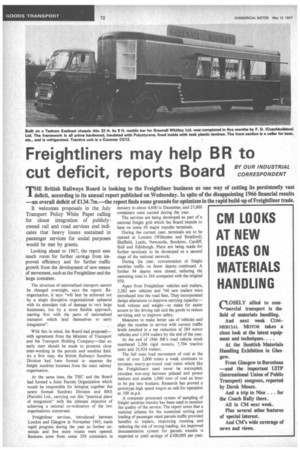Freightliners may help BR to cut deficit, reports Board
Page 74

If you've noticed an error in this article please click here to report it so we can fix it.
THE British Railways Board is looking to the Freightliner business as one way of cutting its persistently vast deficit, according to its annual report published on Wednesday. In spite of the disappointing 1966 financial results —an overall deficit of 1134.7m.—the report finds some grounds for optimism in the rapid build-up of Freightliner trade.
It welcomes proposals in the July Transport Policy White Paper calling for closer integration of publicly owned rail and road services and indicates that heavy losses sustained in passenger services for social purposes would be met by grants.
Looking ahead to 1967, the report sees much room for further savings from improved efficiency and for further traffic growth from the development of new means of movement, such as the Freightliner and the large container.
The structure of nationalized transport cannot be changed overnight, saYs the report, Reorganization, it says "will best be achieved not by a single disruptive organizational upheaval with its attendant risk of damage to very large businesses, but by a more flexible approach, starting first with the parts of nationalized transport which lend themselves to early integration".
With this in mind, the Board had proposed— with agreement from the Minister of Transport and the Transport Holding Company—that an early start should be made to promote close inter-working in the parcels and sundries field. As a first step, the British Railways Sundries Division had leen formed to separate the freight sundries business from the main railway organization.
At the same time, the THC and the Board had formed a Joint Parcels Organization which would be responsible for bringing together the newly formed Sundries Division and BRS (Parcels) Ltd., carrying out this "practical piece of integration" with the ultimate objective of achieving a rational co-ordination of the two organizations concerned.
Freightliner services, introduced between London and Glasgow in November 1965, made rapid progress during the year as further terminals and five more routes were opened. Business grew from some 350 containers in January to about 4,600 in December, and 27,000 containers were carried during the year.
The services are being developed as part of a national freight grid which the Board intends to base on some 50 major transfer terminals.
During the current year, terminals are to be opened at London (Willesden and Stratford), Sheffield, Leeds, Newcastle, Stockton, Cardiff, Hull and Edinburgh. Plans are being made for further terminals to be developed as a second stage of the national network, During the year, concentration ol freight sundries traffic on fewer depots continued. A further 94 depots were closed, reducing the operating total to 266 compared with the original 950.
Apart from Freightliner vehicles and trailers, 2,282 new vehicles and 746 new trailers were introduced into the road fleet. They incorporated design alterations to improve carrying capacity— both volume and weight—to make for easier access to the driving cab and the goods to reduce servicing and to improve safety.
Measures to make better use of vehicles and align the number in service with current traffic levels resulted in a net reduction of 389 motor vehicles and 1,956 trailers by the end of the year.
At the end of 1966 BR's road vehicle stock numbered 3,206 rigid motors, 7,704 tractive units and 25,924 trailers.
The full train load movement of coal at the rate of over 2,000 trains a week continues to increase; merry-go-round coal trains which like the Freightliners need never be uncoupled, circulate non-stop between pithead and power stations and enable 1.000 tons of coal an hour to be put into bunkers. Research has proved a prototype high speed wagon as safe for operation at 100 m.p.h.
A computer processed system of sampling of freight sundries transits has been used to monitor the quality of the service. The report notes that a national scheme for the numerical sorting and loading of passenger rated parcels traffic provided benefits to traders, improving routeing and reducing the risk of wrong loading. An improved documentation system for parcels transits is expected to yield savings of £100,000 per year.
















































































































































































































































